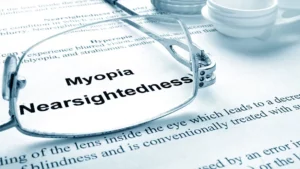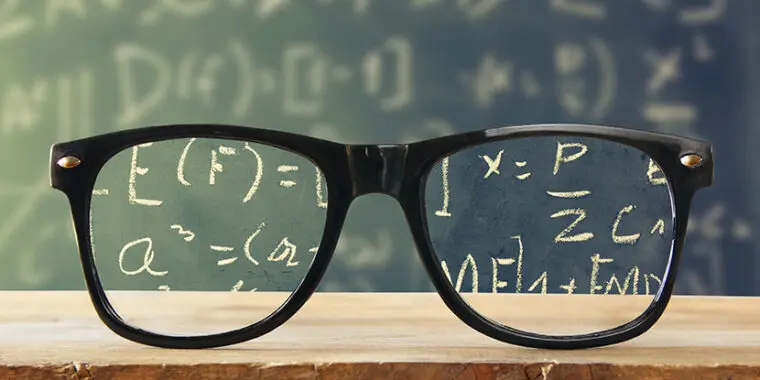If you are reading this, it is likely that you or someone you know suffers from myopia, also known as nearsightedness. Myopia is a condition in which objects up close are clearly visible, while objects farther away are blurry. This can be a major inconvenience for those who suffer from it, and can even lead to blindness in severe cases. In this comprehensive guide, we will discuss the causes of myopia, the symptoms associated with it, and the various treatment options available. We hope that this information will help you better understand this condition and find the best possible treatment for you or your loved one!
Contents
Defining Myopia
 One may have heard of phrases like “nearsighted” or “farsighted,” but what does this actually mean? In order to understand myopia, it is first important to understand how our eyes work. We see when light enters our eye and hits the retina, which is a layer of nerve cells at the back of the eye. The retina then sends a signal to the brain, which interprets this signal as an image. In people with myopia, the eye is shaped such that the light hits the retina before it has a chance to focus. This results in a blurry image being sent to the brain and thus leads to nearsightedness.
One may have heard of phrases like “nearsighted” or “farsighted,” but what does this actually mean? In order to understand myopia, it is first important to understand how our eyes work. We see when light enters our eye and hits the retina, which is a layer of nerve cells at the back of the eye. The retina then sends a signal to the brain, which interprets this signal as an image. In people with myopia, the eye is shaped such that the light hits the retina before it has a chance to focus. This results in a blurry image being sent to the brain and thus leads to nearsightedness.
It is important to note that myopia is not simply a result of not being able to see far away. In fact, most people with myopia can see just fine at a distance, but only if they are wearing corrective lenses such as glasses or contact lenses. This is because the eye is still technically “focusing” the light, albeit in the wrong place.
Causes
Since the eye is shaped differently in people with myopia, what causes this difference? There are a few different things that can contribute to the development of myopia.
- First, it can be hereditary. If your parents or grandparents suffer from myopia, you are more likely to develop it as well.
- Second, it can be due to excessive close work. This could be things like reading, using the computer, or any other activity that requires you to focus closely on an object.
- Third, it can be a result of environmental factors. One example of this is spending too much time indoors. Studies have shown that people who spend more time outdoors are less likely to develop myopia.
- Moreover, it is important to note that myopia typically develops in childhood and early adolescence. This is likely due to the fact that our eyes are still growing during these years.
These are all the possible causes of myopia. However, it is important to remember that not all of these factors will lead to myopia in every person. In fact, the vast majority of people with myopia have no known cause.
Warning Signs
 So, how can you tell if you or your child has myopia? There are a few different symptoms associated with this condition.
So, how can you tell if you or your child has myopia? There are a few different symptoms associated with this condition.
The most obvious symptom is difficulty seeing things that are far away. This could be things like the blackboard at school or the TV from across the room.
Another common symptom is headaches. This is usually a result of the eye strain that comes from squinting to see things clearly.
In children, myopia may also lead to a decline in school performance. This is because they cannot see the blackboard or their books as well, which makes it difficult to learn.
Some other symptoms include:
- Eye fatigue: This is when your eyes feel tired and strained after spending a long time looking at something.
- Double vision: This is when you see two images of the same thing, instead of one clear image.
- Head turns: This is when you find yourself turning your head in order to see things better.
- Blurry vision: This is when objects appear fuzzy or unclear.
- Difficulty seeing at night: This is when you have trouble seeing things in low light conditions.
However, it is important to remember that not everyone with myopia will experience all of these symptoms. If you are experiencing any of these symptoms, it is important to see an eye doctor as soon as possible. They will be able to properly diagnose you and determine the best course of treatment.
Consequences
While it may seem like a minor inconvenience, myopia can actually lead to some serious problems.
First and foremost, it can lead to an increased risk of accidents. This is because people with myopia have difficulty seeing things that are far away. This means that they may not see a car coming or an object in their path, which could lead to an accident.
Second, it can lead to poor vision later in life. This is because the longer someone has myopia, the more their eyesight will deteriorate. In severe cases, people with myopia can even go blind.
Finally, myopia can lead to social problems. This is because people with myopia may have difficulty participating in activities that require good vision, such as sports or driving. This can lead to feelings of isolation and frustration.
All these physical-social consequences underscore the importance of getting myopia treated as soon as possible.
Diagnosis
If you suspect that you or your child has myopia, the best thing to do is to see an eye doctor. They will be able to give you a comprehensive eye exam and determine if you have this condition.

- There are a few different ways to test for myopia. The first is by using a Snellen chart. This is the chart with the big E at the top that most people are familiar with. The doctor will have you stand 20 feet away from the chart and read the letters aloud. If you cannot read the letters on the bottom row, this indicates that you have myopia.
- Another way to test for myopia is with a retinoscopy. This is a test where the doctor shines a light into your eye and then uses a special lens to see how your eye reacts. This will give them a better idea of the severity of your myopia.
- The last way is with a computerized tomography scan. This is a special type of X-ray that can take pictures of the inside of your eye. This will help the doctor to see how severe your myopia is.
Once the doctor has determined that you have myopia, they will then determine the severity. This is done by measuring how far away you can see clearly.
The doctor will also take into account the symptoms that you are experiencing and how they are impacting your life. This can be done with a questionnaire or by talking to you about your daily activities.
Ways To Correct It
 The good news is that myopia is treatable. There are a few different options available, and the best one will depend on the severity of your condition.
The good news is that myopia is treatable. There are a few different options available, and the best one will depend on the severity of your condition.
- The first option is to use glasses or contact lenses. This is the most common treatment for myopia and it is usually very effective. They work by bending the light that enters your eye in a way that allows you to see things more clearly
- The second option is to have surgery. This is usually only recommended for people with severe myopia. The surgical procedure involves correcting the shape of your eye so that light can properly focus on your retina.
- The third option is to use special exercises or devices. These are usually only recommended for people with mild myopia. The exercises and devices help to train your eyes to focus properly.
- The fourth option is to use medication. This is a new treatment that is still being researched. The medication helps to slow down the progression of myopia. This medication includes atropine drops, pirenzepine gel, and brinzolamide suspension.
The best way to treat myopia is to see an eye doctor as soon as possible. They will be able to properly diagnose you and determine the best course of treatment.
There are also some prevention methods that can help to reduce your risk of developing myopia.
Some of these methods include:
- Wearing sunglasses: This helps to protect your eyes from the harmful UV rays of the sun.
- Eating a healthy diet: This helps to keep your eyes healthy and strong.
- Exercising regularly: This helps to improve blood circulation to your eyes.
Myopia is a common condition that can cause a lot of problems if it is not treated properly. However, the good news is that there are a few different treatment options available. If you think that you or your child may have myopia, it is important to see an eye doctor as soon as possible.
Conclusion
In conclusion of the above, myopia is a condition that can cause a lot of problems if it is not treated properly. However, the good news is that there are a few different treatment options available. If you think that you or your child may have myopia, it is important to see an eye doctor as soon as possible.
If you have any more questions, feel free to contact Eye Mantra’s experts. We offer lasik surgery, which is a safe 10-minute procedure to help you get rid of glasses. EyeMantra offers the most advanced lasik options including PRK, Femto Lasik , SMILE surgery, Standard lasik and Contoura vision. If you have any questions on lasik surgery, lasik surgery cost and lasik procedure, call us at +91-9711116605 or email at eyemantra1@gmail.com.


